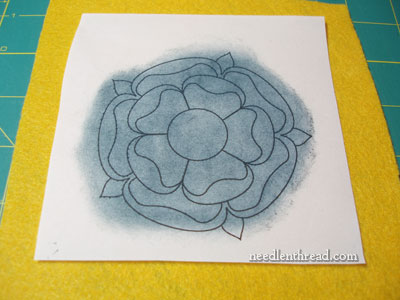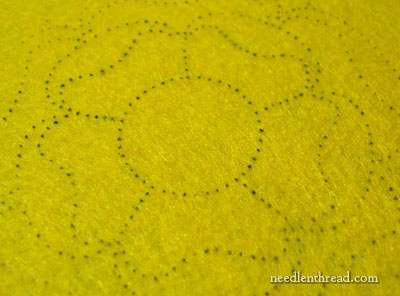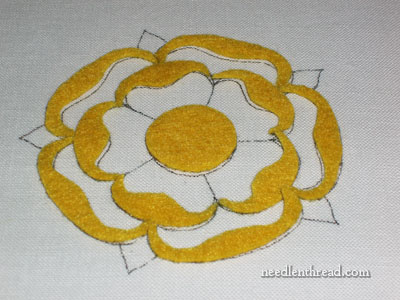A little background, so you can see where I’m coming from: felt is used to pad goldwork. That is, it’s cut into the shape of whatever area is being filled with goldwork threads, sewn onto the ground fabric, and then the goldwork threads are worked on top of it. Using felt accomplishes a few things: 1. it lifts the goldwork a little bit; 2. it “fills” the background behind the goldwork with yellow, so that the ground fabric doesn’t peek through; 3. it gives the goldwork some shape and a cushion.
My favorite felt for padding goldwork is wool felt, but it’s not always easily available in gold or yellow. If I want it, I usually have to special order it online. So I often use craft felt that comes off a bolt, and it suffices. Bolted felt (the stuff you buy by the yard at the fabric store) is much firmer than the craft felt squares that you can buy for a few cents.
When padding goldwork with felt, you have to transfer your design onto your ground fabric and also onto the felt, because you want to be able to cut the exact same shapes from the felt. There are several ways to transfer a design onto felt in order to cut it for goldwork use, and one of them is prick and pounce.

Would you believe me if I told you that you do this the same exact way that you prick and pounce any embroidery design for any kind of fabric? Well – it’s true. You do. If you’d like to see how to use the price and pounce method for design transfer, you can check out my photo tutorial.

But this is The Thing: for cutting out goldwork shapes, after you pounce the design onto your felt, you don’t actually have to draw over it again before cutting out your shapes. You can just carefully cut.
If you don’t jiggle your fabric around too much or smear your little fingers all over it, the pounce dots will stick to the felt long enough for you to carefully cut out all the little pieces you want to use.

It works a charm!
This is not my favorite technique for cutting out felt shapes for goldwork, but since I was in a hurry, and since I didn’t want to run back inside to use my printer, I thought I’d try it. I already had the pattern pricked, after all. It worked fine, and it took me a total of about 4 minutes to pounce the design and cut out all the pieces.
Incidentally, this is my large Tudor-style rose, not to be mistaken for the small Tudor-style rose. I’ll be working this rose in goldwork & silk like the small one, only using different goldwork techniques and different silk threads.
Well. That was fun, wasn’t it? Next time you want to transfer a pattern easily to felt for cutting out pieces, consider pricking your design and pouncing the pattern on!







Thank you, Mary. What clever tips you always have!
You have no idea how I go about my life giving advice about this or that to others and saying that I read it on Mary Corbet’s blog 😉
Have a good weekend, though this weekend is kind of a sober one for all of us. God grant us Peace.
The Lord bless you.
Doris HH
Have you ever used leather for the padding? When I saw the kroje (sp?) exhibit a while back, many of the headpieces had silverwork over leather padding, IIRC. I’m thinking it might have been 1/16 – 1/8″ thick leather on some parts.
I’ve heard of it, but not tried it myself, Gail. In fact, I don’t think I probably would. I think leather is a pain in the neck to sew through! 🙂 I’ve worked with card as padding, and it works well…. but not quite the same as leather, I suppose! ~MC
Thank you for the nice tip!
wait… you use a printer for your felt? Actually I can see that working with inkjet, I guess it would only work for stiffer fabrics, though?
Hi, Tessa – No, no…. I don’t put felt through the printer! But I do put either fusible interfacing or freezer paper through the printer, then iron them to the felt, then cut. The fusible interfacing makes cutting the felt really easy. The freezer paper, if you iron it too much, might stick a bit to the felt. With the fusible interfacing, you have to flip the design if you want the interfacing side down, which is usually how I do it. I don’t fuse the felt to the fabric, though. I still stitch it on. ~MC
I hadn’t thought of pouncing felt, but looks like it would work since you don’t need to preserve the design to stitch over.
Re the leather, might it be more flexible, tougher and protect the goldwork becaue of that?
Also, you wouldn’t have to stitch through it. In JE you use Yamato’s paste to glue down card. Granted you do stitch the card down, but you might be able to only tack the leather if you pasted it. Just a thought. Worth trying.
Thanks, Anne – I guess that would work if you were just covering the leather from side-to-side, but when I use felt for padding, I’m generally stitching through it, either with couching stitches or chip work, etc. ~MC
Oh dear, I hope four minutes is an exaggeration. I thought I’d reconciled myself to being the slowest needleworker ever, but now you’ve set the bar even higher :-).
I’ve learned so much from you — thanks.
Hi, Georgia – I didn’t sew them on yet! 🙂 I just cut them out and laid them on the fabric! ~MC
Hi
Can you remind me where one can get pounce and the little pounce blotter? I can’t seem to find it for love nor money!
Thanks
Audrey
Weellllll, Audrey, it’s kind of hard to find. Tanja Berlin makes and sells it on her website, http://www.berlinembroidery.com. You used to be able to buy it through Lacis (www.lacis.com), but I don’t know if they still carry it. Recently, I bought a whole jar of charcoal powder from Blick’s Art Supplies, which I’m going to try out as pounce. It’s sold for drawing and artwork, but it’s just charcoal powder, so it should work. I’ll post about it, once I give it a try. It’s pretty reasonable – a good sized jar for less than $10, with enough to pretty much last through any embroidery projects you’d ever want to do, methinks. As for the “blotter,” you can make your own, by rolling up some felt nice and tight and putting a rubber band around it. Hope that helps!
MC
try buying felt at A Child’s Dream Come True….they have a great selection of different kinds of wool felt.
http://achildsdream.com/
Brilliant! I’ll have a go when I get up to prink and pouncing a design. 🙂
Thanks, Mary! I assume freezer paper is what we call baking paper in SA? Our cooking alternative is waxed/greaseproof which I don’t see playing well with a printer ^_^
By the way, regarding leather, I have seen some folk here using a punch-like tool to pre-perforate leather once it’s cut. They then use those holes to stitch through. Maybe that would simplify things for people who want to try it?
Hi, Tessa – I think it’s called butcher paper. It’s waxy on one side. The side that’s not waxy is the side you print on. Yes, you’re right – holes can be “pre-punched” into the leather but I don’t think that would be too time efficient when doing chip work and so forth. When it comes to the leather, unless it’s a visible part of the design, I can’t see putting the expense into using leather as padding. Now, if it’s kid leather that’s been coated with gold or whatnot (as is often used in metal thread work) and is part of the design, it would make sense. But if it’s going to be covered up, since it’s both expensive and difficult to stitch with, I’d just stick with felt.
~MC
Thanks – I haven’t tried this yet, so the scale of the projects hasn’t really sunk in, I guess.
Thanks so much for sharing this! I’m always getting grouchy about transferring patterns to felt, and you’ve just saved me a ton of time.
I never would of thought to do this. I have just be using tracing paper where I trace the pattern I want to stitch on to the tracing paper. Once I traced the pattern I then pin it to the felt and stitch through it. When I am done stitching the tracing paper just tears away easily. I will have to try this out! Thanks! 🙂